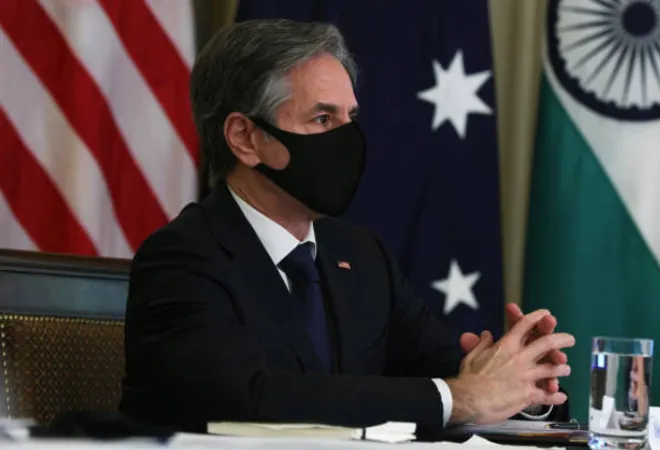-
CENTRES
Progammes & Centres
Location
Moving beyond the anti-China rhetoric, US has attempted to enhance its diplomacy efforts towards Southeast Asia as a whole.
 The United States Secretary of State, Antony Blinken, recently embarked on his maiden Southeast Asia tour starting with the Indonesian capital, Jakarta, after which he was heading to Malaysia and Thailand. The visit had to be cut short after a member of the press traveling with the Secretary tested positive for COVID-19, as was reported by the State Department. Secretary Blinken was poised to end his visit by meeting the Thai Deputy Prime Minister and Foreign Minister Don Pramudwinai. This trip is an attempt to step up the current US administration’s diplomacy efforts in a region which has been caught in the middle of the US-China contestation in the Indo-Pacific. The main message that has been put forward is that “the United States is a better bet as a partner than China, even if it’s not spending so lavishly in the region.” Since taking office in January 2021, US President Joe Biden has not made any personal attempts to reach out to his Southeast Asian counterparts, and thus, the Biden administration’s engagement with Southeast Asia has had a rocky start. But lately there have been visits by Deputy Secretary of State Wendy Sherman to Indonesia, Thailand, and Cambodia in June 2021. Most recently, Vice President Kamala Harris also travelled to Singapore and Vietnam in August 2021. While US was slow in reaching out to its Southeast Asian allies and friends, Chinese State Councillor and Foreign Minister Wang Yi welcomed ASEAN foreign ministers at an in-person gathering, where assurances of economic assistance and the smooth flow of aid for COVID-19-related emergencies were made. Therefore, it seemed only logical for the United States to think of rebooting its diplomatic efforts in Southeast Asia through these high-level visits.
The United States Secretary of State, Antony Blinken, recently embarked on his maiden Southeast Asia tour starting with the Indonesian capital, Jakarta, after which he was heading to Malaysia and Thailand. The visit had to be cut short after a member of the press traveling with the Secretary tested positive for COVID-19, as was reported by the State Department. Secretary Blinken was poised to end his visit by meeting the Thai Deputy Prime Minister and Foreign Minister Don Pramudwinai. This trip is an attempt to step up the current US administration’s diplomacy efforts in a region which has been caught in the middle of the US-China contestation in the Indo-Pacific. The main message that has been put forward is that “the United States is a better bet as a partner than China, even if it’s not spending so lavishly in the region.” Since taking office in January 2021, US President Joe Biden has not made any personal attempts to reach out to his Southeast Asian counterparts, and thus, the Biden administration’s engagement with Southeast Asia has had a rocky start. But lately there have been visits by Deputy Secretary of State Wendy Sherman to Indonesia, Thailand, and Cambodia in June 2021. Most recently, Vice President Kamala Harris also travelled to Singapore and Vietnam in August 2021. While US was slow in reaching out to its Southeast Asian allies and friends, Chinese State Councillor and Foreign Minister Wang Yi welcomed ASEAN foreign ministers at an in-person gathering, where assurances of economic assistance and the smooth flow of aid for COVID-19-related emergencies were made. Therefore, it seemed only logical for the United States to think of rebooting its diplomatic efforts in Southeast Asia through these high-level visits.
Since taking office in January 2021, US President Joe Biden has not made any personal attempts to reach out to his Southeast Asian counterparts, and thus, the Biden administration’s engagement with Southeast Asia has had a rocky start.In his address at Universitas Indonesia on December 14, 2021, Secretary Blinken laid out five core principles that captures the US’ vision of a Free and Open Indo-Pacific, which is also shared by its other like-minded partners and allies in the region. The main idea behind putting forward these core elements was to downplay the direct confrontation between the US and China and ensure that the US is seeking to strengthen relations with the Indo-Pacific nations. China’s aggressive actions, for instance, in the South China Sea was obviously stressed upon- “Beijing’s action in the South China Sea puts at risk the movement of more than US $3 trillion (S$4 trillion) worth of commerce every year.” But unlike the previous visits and statements, lashing out on China was not the primary motive. This time serious effort was made to point out that “countries have the right to choose their own path free from coercion and intimidation” and that it is "not about a contest between a US-centric region or a China-centric region as the Indo-Pacific is its own region.” Therefore, a shift in the US approach is noticeable in this visit. The fact that the Southeast Asian countries have repeatedly proclaimed that they are not comfortable in choosing sides seems to have been paid heed to by the US government. The five core elements did lay out a clearer picture for the ASEAN member countries as to what the US’ true intentions are through its Indo-Pacific strategy and that this strategy is not only meant for deterring and countering the Chinese rise. The first principle espouses the need for problems to be dealt with openly and rules to be reached transparently and that governance should be transparent and for the people. The second principle underlines the US’ commitment to “forge stronger connections within and beyond the region”. Third and the most noteworthy one is that the United States is ready to invest and do more financially in this region if the need arises. This has been announced as there are speculations that the Biden administration is preparing to roll out a comprehensive economic framework for the Indo-Pacific. The Southeast Asian countries have always demanded the US to invest more substantially in the region, so the upcoming comprehensive economic framework can prove to be positive step forward. Though the United States have announced infrastructure and connectivity initiatives like the Blue Dot in the past with a view to provide a better alternative to China’s Belt and Road Initiative, but it has not borne much fruit. Amidst suspicions that the ongoing pandemic might slow down the Chinese economy as well which will have a direct bearing on the progress and investments of the BRI projects, this would be a good opportunity for the United States to capitalise by implementing a proper economic framework for the Indo-Pacific, in which Southeast Asia can be the core area of focus. Fourth, the US will help build a more resilient Indo-Pacific, especially given the pandemic; and lastly, the US aims to bolster Indo-Pacific security, that is with the evolving threats, the approach to deal with them should also evolve and this can be done through alliances and partnerships.
The Southeast Asian countries have always demanded the US to invest more substantially in the region, so the upcoming comprehensive economic framework can prove to be positive step forward.Secretary Blinken also stressed on ASEAN centrality in his address and assured that Washington still has faith in the working of the ASEAN. For instance, with regard to the Myanmar coup, he pointed out that the US has galvanised international support that continues to press the regime to cease the use of violence, release all those unjustly detained, allow unhindered humanitarian access to help restore Myanmar to the path of inclusive democracy. But he still showed support for the ‘five-point consensus’ reached between ASEAN and Myanmar coup leader, Min Aung Hlaing. Biden administration’s lukewarm approach towards Southeast Asia had raised doubts about this administration’s prolonged commitment to Asia as well. Additionally, just anti-China rant and not being able to present a concrete Southeast Asia policy was not helping either. Trump administration’s walking away from the Trans-Pacific Partnership is a memory still afresh in the minds of the Southeast Asian leaders. Therefore, besides the increased investments that US is promising to the ASEAN countries in these high-level visits, there will also be expectations from Washington to deeply engage Southeast Asia through support for the Comprehensive and Progressive Agreement for Trans-Pacific Partnership and the Regional Comprehensive Economic Partnership. Given Southeast Asia’s geographical clout in the Indo-Pacific, it needs to feature in the Indo-Pacific policies of all countries. Moreover, this is the region which has not just been at the receiving end of Chinese expansionist activities in the South China Sea, but also one of the top recipients of Chinese investments under the Belt and Road Initiative. Thereby, if the US is looking to forge alliances and partnerships to deal with the China challenge in the Indo-Pacific, strengthening connections with Southeast Asia becomes a must as well. Providing substantial economic investments to meet the infrastructure development demands in Southeast Asia is the way forward. Therefore, as US National Security Council Indo-Pacific coordinator, Kurt Campbell, had put it, “For an effective Asia strategy, for an effective Indo-Pacific approach, you must do more in Southeast Asia.”
The views expressed above belong to the author(s). ORF research and analyses now available on Telegram! Click here to access our curated content — blogs, longforms and interviews.

Premesha Saha is a Fellow with ORF’s Strategic Studies Programme. Her research focuses on Southeast Asia, East Asia, Oceania and the emerging dynamics of the ...
Read More +